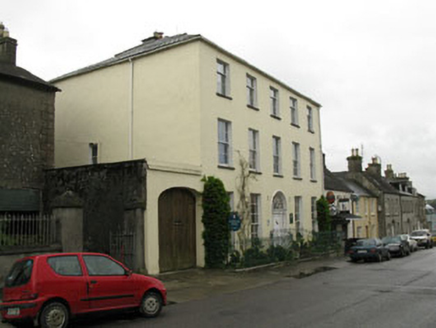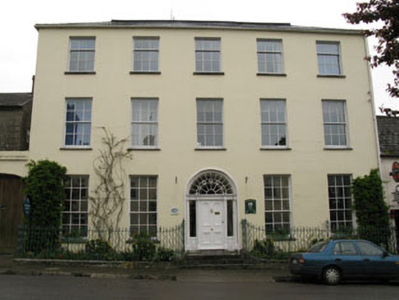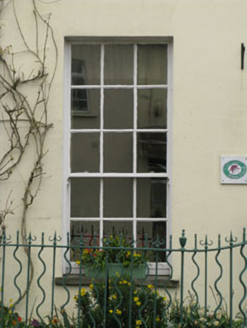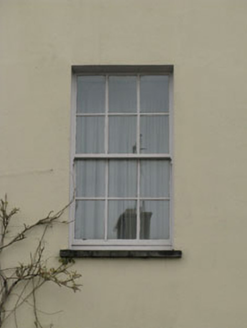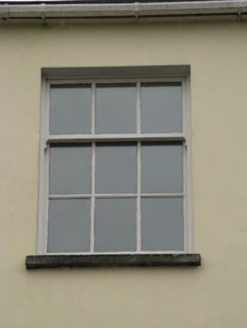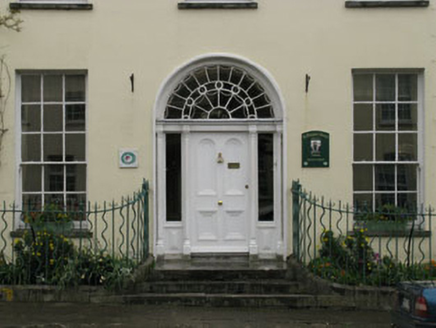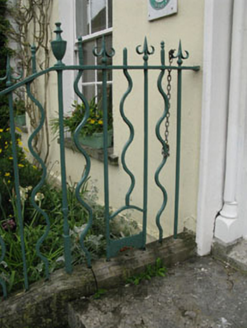Survey Data
Reg No
20844023
Rating
Regional
Categories of Special Interest
Architectural, Artistic, Historical, Social
Original Use
House
In Use As
Guest house/b&b
Date
1815 - 1820
Coordinates
148946, 55392
Date Recorded
23/04/2009
Date Updated
--/--/--
Description
Attached five-bay three-storey house, dated 1818, having attached arch-way to side (north-west), and central single-bay two-storey porch with conservatory to rear (north-east). Hipped slate roof with central valley, rendered chimneystacks, eaves course and uPVC rainwater goods. Pitched timber framed glazed roof to porch. Diminishing square-headed window openings with tooled limestone sills throughout, having internal timber shutters. Nine-over-six pane timber sliding sash windows to ground floor of front elevation, six-over-six pane timber sliding sash windows to first floor of front and rear elevations, and three-over-six pane timber sliding sash windows to second floors of front and rear elevations. Two-over-two pane timber sliding sash window to side (north-west) elevation. Multiple-pane central stairwell window to rear elevation. Timber-framed tripartite window to ground floor of rear elevation having central four-over-four pane timber sliding sash window flanked by two-over-two pane timber sliding sash windows. Replacement multiple-pane timber casement windows to ground floor, rear elevation and porch. Timber casement windows to conservatory. Round-headed door opening to front elevation within timber doorcase and raised render surround, having limestone stepped approach. Limestone plinth blocks to doorcase supporting engaged colonettes and architrave. Timber panelled door flanked by sidelights, surmounted by decorative spoked fanlight. Elliptical-headed carriage arch with rendered parapet wall, coping and double-leaf timber battened doors to front elevation. Tooled limestone plinth with decorative wrought-iron railings incorporating boot scrapes to front (south-west) elevation. Freestanding ten-bay two-storey former coach house having two-bay off-centred pedimented break front bay to front (north-west) elevation. Now in use as rented accommodation. Pitched slate roof with rendered chimneystack and recent rooflights. Exposed rubble and ashlar stone walls with stringcourse to ground floor and to eaves level of breakfront bay. Square-headed window openings with stone block voussoirs, three-over-six timber sliding sash windows to ground floor front and first floor of side (north-east) elevations. Ocular window openings to first floor, having stone voussoirs and replacement windows. Elliptical-headed former integral carriage arches to breakfront bay, having stone voussoirs, now accommodating double-leaf glazed doors flanked by sidelights. Square-headed door openings to front elevation having timber battened doors to ground and first floor of side (north-east) elevation. Extensive walled garden to rear of main house.
Appraisal
This large scale house occupies a prominent position on Kilbrogan Hill. The house retains much of its historic form through retention of key features including a fine slate roof, diminishing sash windows and ornate doorcase. Decorative wrought-iron railings incorporating boot scrapes compliment the facade. The house possesses many finely crafted details including tooled stone sills, exterior limestone steps and decorative plaster work to the interior. The house has a colourful history associated with the local area. It occupies the site of an earlier house and was originally part of the Bandon Estate of Spencer Compton, the 6th Duke of Devonshire. Throughout its history it was occupied by a number of prominent local business people, including Richard Wheeler Doherty, local solicitors the McCarthy family, and most notably Joseph Brennan who owed a local bakery, brewery, a mill and electric company ( which supplied electricity to the town from 1919-1939) and some smaller businesses. Dr. Joseph Brennan, son of the previous Brennan, became the chairman of the Irish Currency Commission from 1927 until 1943, and later first governor of the Central Bank of Ireland from 1943 to 1953, with his signature appearing on Irish currency notes for many years.
